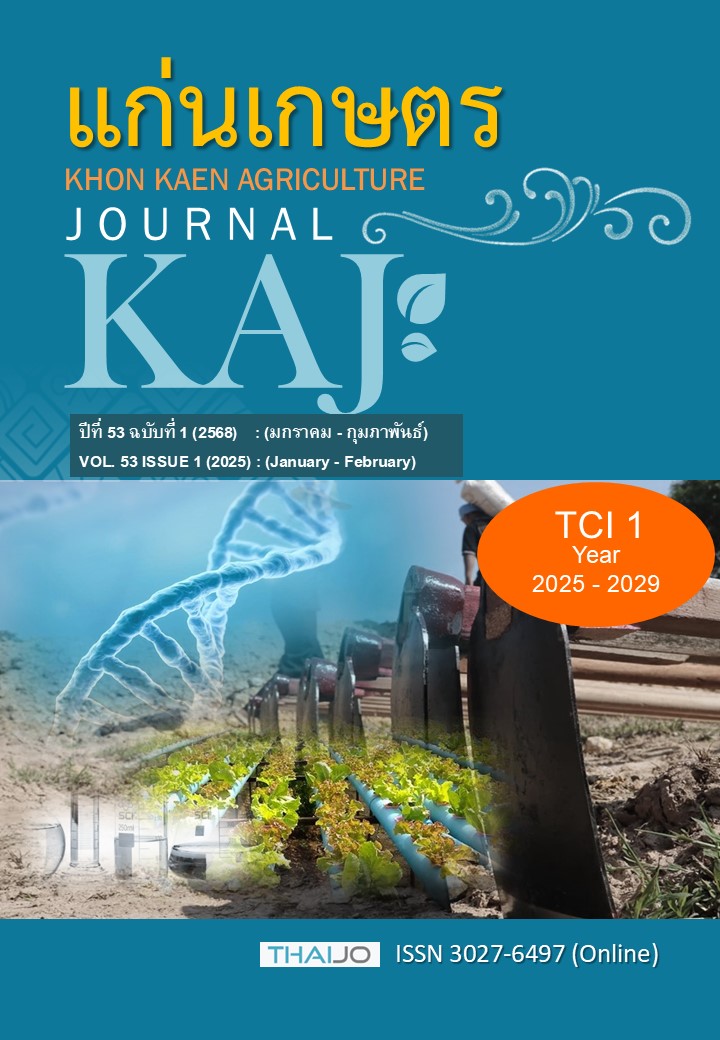Honeybee (Apis spp.) food plants: Sustainable and environmentally friendly orchard management
Main Article Content
Abstract
Honeybees are important social and beneficial insects by pollinating cross-pollinated plants for fruit setting and ultimately increasing production. The result of inadequate bee vegetation in the orchard led to a shortage of honeybees. Therefore, the study aimed to investigate the species diversity of plants with nectar and /or pollen sources, floral character and floral period in the economic orchard. A study of bee flora made in 6 orchards of Prachinburi Province during November 2022 to December 2023. Throughout the course of ten minutes, at least three visits to the blooming plants by honeybees were noted. Plants species, characteristics, colour and scent were recorded. For investigated of the nectary, some flowers were collected to the laboratory. The result found 53 species of indigenous and exotic plants belonging to 33 families. The growth form of bee forage comprises tree and shrubby tree, shrub, herb and the other were 30, 9, 8, and 6 species respectively. Plants that produce nectar were found to be 42 species. Honeybees preferred white or yellow inflorescence flowers with scent. The floral dearth period of duration was from July to September. Maintaining the diversity of certain tree-type food plants in orchards helps sustainably enhance nesting sites and food sources for bees. The results are beneficial for farmers who use bee ecosystem services to increase productivity and for beekeepers.
Article Details

This work is licensed under a Creative Commons Attribution-NonCommercial-NoDerivatives 4.0 International License.
References
ก่องกานดา ชยามฤต และวรดลต์ แจ่มจำรูญ. 2559. คู่มือจำแนกพรรณไม้. สำนักงานหอพรรณไม้ สำนักวิจัยการอนุรักษ์ป่าไม้และพันธุ์พืช กรมอุทยานแห่งชาติ สัตว์ป่า และพันธุ์พืช. กรุงเทพฯ.
กลุ่มงานยุทธศาสตร์และข้อมูลเพื่อการพัฒนาจังหวัด. 2565. แผนพัฒนาจังหวัดปราจีนบุรี พ.ศ. 2561-2565. แหล่งข้อมูล: https://www.prachinburi.go.th/yut-prachin/plan61-65-65.pdf. ค้นเมื่อ 12 มกราคม 2567.
เฉลิม อ่อนละมัย. 2546. นิเวศวิทยาของการเลือกสถานที่สร้างรังและผลของแหล่งอาหารต่อการสร้างไข่ของผึ้งมิ้ม (Apis florea F.) ในจังหวัดขอนแก่นและมหาสารคาม. วิทยานิพนธ์ ปริญญาวิทยาศาสตรดุษฎีบัณฑิต มหาวิทยาลัยเทคโนโลยีสุรนารี. นครราชสีมา.
ธัชคณิน จงจิตวิมล และสหณัฐ เพชรศรี. 2558. รายงานวิจัยฉบับสมบูรณ์ ละอองเรณูพืชอาหารของแมลงผสมเกสรในวงศ์ Apidae (Hymenoptera) ในพื้นที่อุทยานแห่งชาติภูหินร่องกล้า จังหวัดพิษณุโลก. ประจำปีงบประมาณ 2557. คณะวิทยาศาสตร์และเทคโนโลยี มหาวิทยาลัยราชภัฏพิบูลสงคราม, พิษณุโลก.
เบญจวรรณ ชิวปรีชา, รุ่งวิทย์ ชัยจิรวงศ์ และชัยมงคล คงภักดี. 2563. ความหลากหลาย สัณฐานวิทยาดอก และเรณูพืชอาหารผึ้งและชันโรงในสวนผลไม้พื้นที่โครงการพัฒนาป่าชุมชนบ้านอ่างเอ็ด (มูลนิธิชัยพัฒนา) อำเภอขลุง จังหวัดจันทบุรี. วารสารวิชาการเกษตร. 38: 241-255.
ปิยมาศ นานอก โสภาลดาวัลย์ และอรจิรา ภิญโญ. 2561. ความหลากหลายของพืชอาหารของผึ้งพันธุ์ (Apis mellifera) ในพื้นที่จังหวัดเลย โดยวิเคราะห์จากก้อนเรณูของผึ้ง. วารสารก้าวทันโลกวิทยาศาสตร์. 18: 128-138.
รสวันต์ อินทรศิริสวัสดิ์, เชิดศักดิ์ เกื้อรักษ์, ศรัณญภัส รักศีล และสุวิมล เกตุทอง. 2561. รายงานวิจัยฉบับสมบูรณ์ นิเวศบริการและความหลากหลายทางชีวภาพที่กลับคืนมาในแปลงวนเกษตรยางพารา. สถาบันวิจัยและพัฒนา มหาวิทยาลัยทักษิณ, พัทลุง.
สิริวัฒน์ วงษ์ศิริ และสุรีรัตน์ เดี่ยววาณิชย์. 2555. ชีววิทยาของผึ้ง. สำนักพิมพ์แห่งจุฬาลงกรณ์มหาวิทยาลัย, กรุงเทพฯ.
สุธีร์ ดวงใจ และยงยุทธ ไตรสุรัตน์. 2558. การศึกษาสังคมพืชโดยใช้แปลงถาวร น.107-120. ใน คู่มือการศึกษาป่าไม้ไทย. บริษัทยูโอเฟ่น จำกัด, กรุงเทพฯ.
สำนักงานหอพรรณไม้. 2557. ชื่อพรรณไม้แห่งประเทศไทย เต็ม สมิตินันทน์ ฉบับแก้ไขเพิ่มเติม พ.ศ. 2557. โรงพิมพ์สำนักงานพระพุทธศาสนาแห่งชาติ, กรุงเทพฯ.
Anders, M., I. Grass, V. M. G. Linden, P. J. Taylor, and C. Westphal. 2022. Smart orchard design improves crop pollination. Journal of Applied Ecology. 60: 624-637.
Behera, L. K., A. A. Mehta, and S. K. Sinha. 2014. Suitable bee flora availability for commercial apiculture during dearth period in the heavy rainfall zone of South Gujarat. Research Journal of Chemical and Environmental Sciences. 2: 65-68.
Brunet, J., M. W. Thairu, J. M. Henss, R. L. Link, and J. A. Kluevert. 2015. The effects of flower, floral display, and reward sizes on bumblebee foraging behavior when pollen is the reward and plants are dichogamous. International Journal of Plant Science. 176: 811-819.
Brys, M. S., P. Skowronsk, and A. Strachecka. 2021. Pollen diet-properties and impact on bee colony. Insect. 12: 1- 9.
Burkle, L. A., C. M. Delphia, and K. M. O’Neill. 2020. Redundancy in wildflower strip species help support spatiotemporal variation in wild bee communities on diversified farms. Basic and Applied Ecology. 44: 1–13.
Chittka, L., and N. E. Raine. 2006. Recognition of flowers by pollinators. Current Opinion in Plant Biology. 9: 428–435.
Dibble, A. C., F. A. Drummond, and L. ฺB. Stack. 2020. Plant origin and other attributes impact bee forage patterns in a common garden study in Maine, United States; Part II. Environmental Entomology. 49: 738–752.
Duangphadee, O., P. Rodim, and P. Kongkaew. 2021. Diversity of bee flora and pollination efficacy to crop yields of native honeybees and stingless bees in Thailand. Research project by Thailand Science Research and Innovation (TSRI) Basic Research Fund. Bangkok.
Guez, D., L. Subias, S. Andrea, and S. Griffin. 2017. Colour and shape preferences of Apis cerana (Java genotype) in Australia. Bulletin of Insectology. 70: 267-272.
Hawkeswood, T. J., and B. Sommung. 2016. Pollination of Muntingia calabura L. (Muntingiaceae) by native bees in Bangkok, Thailand. Calodema. 421: 1-6.
Kowalska, J., M. Antkowiak, and P. Sienkiewicz. 2022. Flower strips and their ecological multifunctionality in agricultural fields. Agriculture. 12: 2-14.
Martins, F. Q., and M. A. Batalha. 2006. Pollination systems and floral traits in Cerrado woody species of the upper Taquari region (Central Brazil). Brazilian Journal of Biology. 66: 543-552.
Momose, K., T. Yumoto, T. Nagamitsu, M. Kato, H. Nagamasu, S. Sakai, R. D. Harrison, T. Itioka, A. A. Hamid, and T. Inoue. 1998. Pollination biology in a Lowland Dipterocarp Forest in Sarawak, Malaysia characteristics of the plant pollinator community in a Lowland Dipterocarp Forest. American Journal of Botany. 85: 1477–1501.
Olana, T., and Z. Demrew. 2019. Identification of Honey Bee Floras and Their Flowering Times in Wondo Genet, Southern Ethiopia. Journal of Resources Development and Management. 59: 1-11.
Pamminger, T., R. Becker, S. Himmelreich, C. W. Schneider, and M. Bergtold. 2019. The nectar report: quantitative review of nectar sugar concentrations offered by bee visited flowers in agricultural and non-agricultural landscapes. PeerJ. 7: 1-15.
Raes, N., L. G. Saw, P. C. Van Welzen, and T. Yahara. 2013. Legume diversity as indicator for botanical diversity on Sundaland, South East Asia. South African Journal of Botany. 89: 265–272.
Staab, M., M. Helena, P. Peixoto, and A. M. Klein. 2020. Exotic garden plants partly substitute for native plants as resources for pollinators when native plants become seasonally scarce. Oecologia. 194: 465–480.
Wayo, K. 2018. The Role of Insects in the Pollination of Durian (Durio zibethinus Murray) Cultivar ‘Monthong’. M.S. Thesis. Prine of Songkla University, Songkla.
Wayo, K., T. Sritongchuay, B. Chuttong, K. Attasopa, and S. Bumrungsri. 2020. Local and Landscape Compositions Influence Stingless Bee Communities and Pollination Networks in Tropical Mixed Fruit Orchards, Thailand. Diversity. 12: 2-17.
Zariman, N. A., N. A. Omar, and A. N. Huda. 2022. Plant attractants and rewards for pollinators: Their significance to successful crop pollination. International Journal of Life Sciences and Biotechnology. 5: 270-293.

